Under the blows of the elements: Kennedy Space Center is preparing for the hurricane "Irma"
The cosmodrome at Cape Canaveral has a lot of advantages, the most important of which are the relatively small initial inclination of the orbit and the sea to the east, where you can easily drop the spent stages. But each place has its drawbacks. The Florida Peninsula regularly finds itself in the path of hurricanes, and now Hurricane Irma is passing next to it. How did the Kennedy Space Center encounter hurricanes, and what damage did they do before?
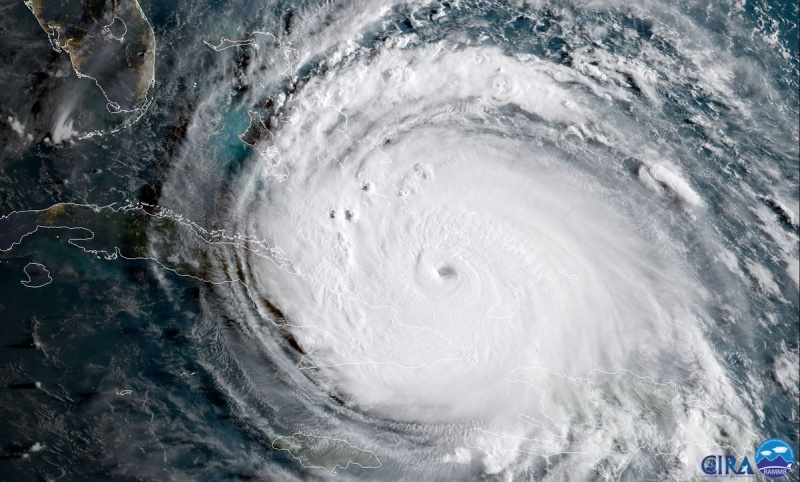
Satellite photo of hurricane "Irma", Friday, Florida peninsula in the upper left corner, photo NOAA
The area where the Kennedy Space Center (KSC) is located, according to statistics, is in medium danger - most of the hurricanes pass south.
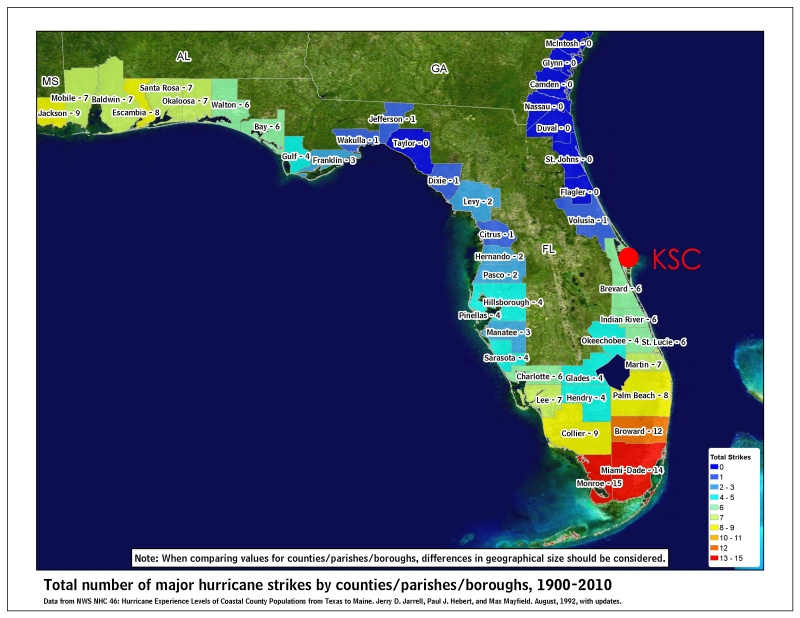
Source: NOAA
Therefore, the architects designed the KSC buildings ready to withstand the impact of hurricanes of the third category (wind up to 180 km / h).

VAB - Vehicle Assembly Building (vertical assembly building), OPF - Orbiter Processing Facility (hangars for preparing shuttles for flight), LCC - Launch Control Center (launch control center), wind in miles per hour. Source: NASA 2006 document
The decision turned out to be generally correct, but in 1992 the south of Florida covered the Andrew hurricane, which belongs to the fifth, highest category (the wind is stronger than 254 km / h). The spaceport was lucky, it turned out to be north of the area of maximum destruction, but after “Andrew” all new buildings now make them resistant to a fourth category hurricane (wind from 200 to 254 km / h). Taking into account this requirement, for example, SpaceX launch facilities were built.
Of course, on Cape Canaveral, the rules for preparing for the arrival of the hurricane were adopted. There are four levels of hurricane hazard HURCON (Hurricane Conditions) at the cosmodrome:
HURCON IV: A wind stronger than 80 km / h is expected within 72 hours. At this stage, the cosmodrome works in the normal mode, the people specified in the hurricane schedule, perform normal work, but are also available for events to prepare for a meeting with the elements
HURCON III: The wind is stronger than 80 km / h is expected within 48 hours. Employees listed in the hurricane schedule, stop normal work and begin to prepare for the hurricane. Other employees can be sent home.
HURCON II: 24 hours before the hurricane. There is a special emergency team of about 120 people.
HURCON I: 12 hours before the hurricane. The emergency team takes place on schedule, all others leave the spaceport, the gate closes until the end of the violence of the elements.
Now at the cosmodrome, the areas where construction work is underway are of the greatest concern. This is a mobile platform for the SLS rocket under development and the SLC 40 launch complex, which is still being repaired by SpaceX after the Falcon 9 last year’s explosion. It was planned that, in the area of October, the 39A launch complex will be transferred to the preparation for the first launch of the Falcon Heavy, and the Falcon 9 launches will be transferred to the SLC 40. Damage from a hurricane may disrupt this schedule.

Mobile SLS platform, NASA photo
Last time, the Kennedy Space Center suffered from Hurricane Matthew in October 2016, and its traces just managed to be eliminated. At that time, at the cosmodrome, the wind recorded 130 km / h and a gust of 219 km / h. That was enough to cause millions of dollars in damage.
The beach house suffered, where the astronauts spent the last hours before the start.
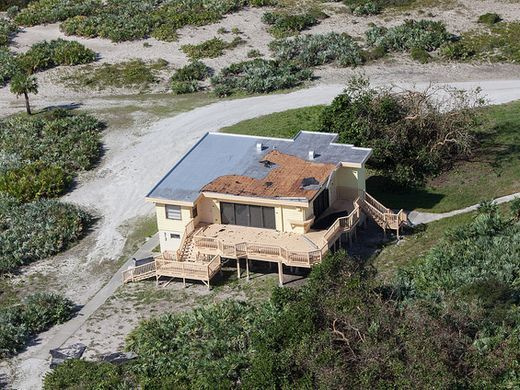
Inspection of the cosmodrome after the hurricane from the air, here and hereafter NASA photo
The roof of the small hangar was damaged.
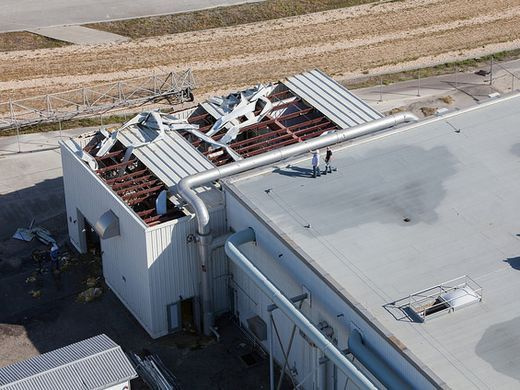
And the roof of the OSB is the office building where the documentation center, library and photo processing departments are located.
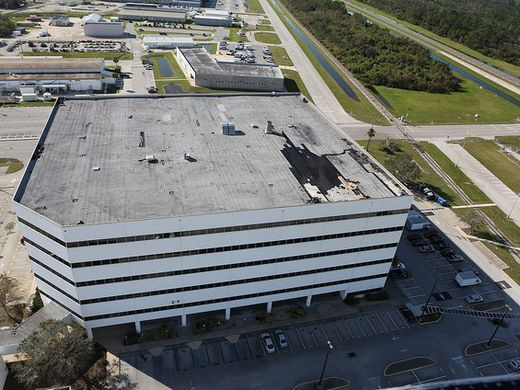
When the shuttles were still flying, they were subject to weather restrictions. The shuttle could not be in the launch sites if the wind was expected to be stronger than 127 km / h, and its transportation to the vertical assembly building had to be completed before the wind reached a speed of 74 km / h and lightning would appear around 30 km. Usually shuttles began to evacuate from the start two days before the hurricane, but history knows unusual solutions. In 2006, when the Atlantis shuttle was preparing for the launch with the STS-115 mission, Hurricane Ernesto began to move towards the cosmodrome. The shuttle was already halfway into the hangar, when the updated meteorological information arrived, according to which at the cosmodrome the wind should not have exceeded 127 km / h. The shuttle was deployed and installed back into the launch site, where he successfully transferred the hurricane.

Shuttle transported back to start, photo by NASA
The Kennedy Center suffered the most severe damage in 2004, when in August and September three hurricanes hit it: Charlie, Francaise and Joanna. The vertical assembly building (VAB) was noticeably damaged; more than eight hundred panels were torn off. It is curious that some of them fell out according to plan - they are specially designed to fall out, equalizing the pressure inside and outside the giant hangar, thereby increasing its strength.
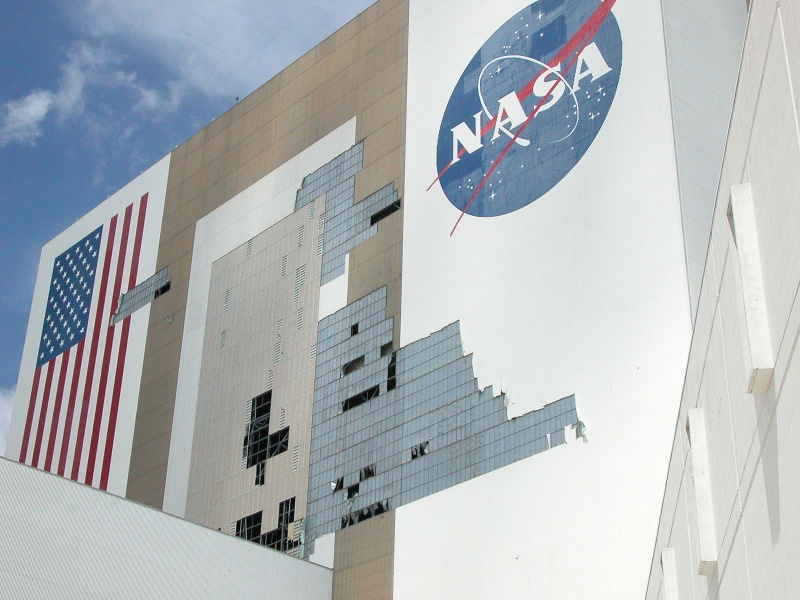
Photo: NASA
And this building was later transferred to SpaceX, in which payloads are being prepared for flight.
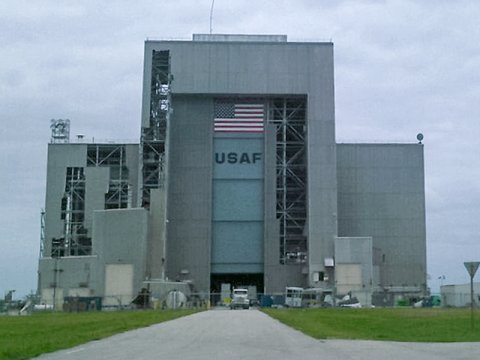
Photo: Business Insider
In the rocket museum, the Navaho rocket was blown off the pedestal.

Photo: SpaceKSCBlog
Fell Mercury Redstone layout.
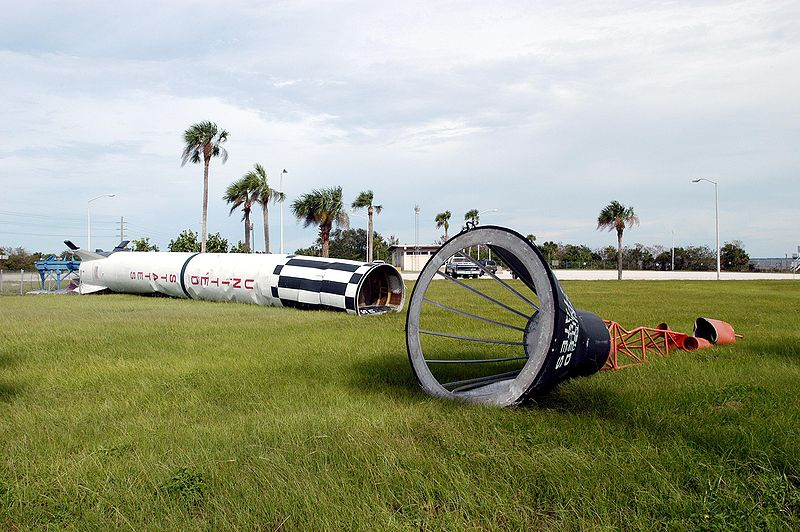
Photo: NASA
Preserved documentary shooting damage.
Fortunately, now the likelihood of such destruction is small - according to the latest data, the hurricane “Irma” has deviated to the west and will pass away from the center of Kennedy.
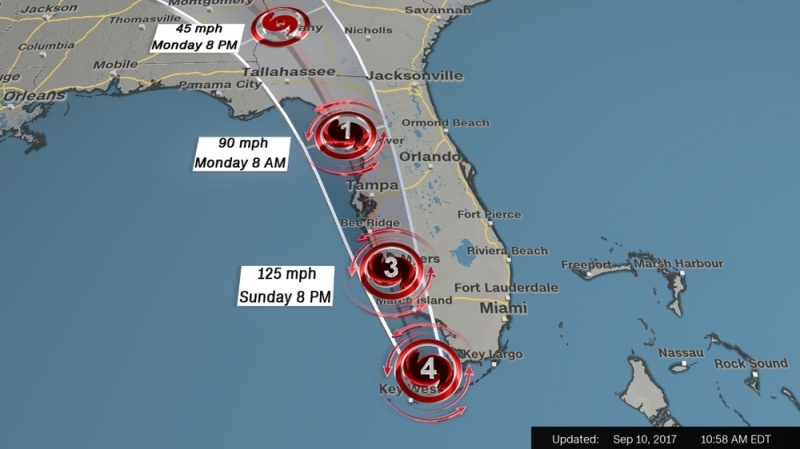
Scheme: CNN

Satellite photo of hurricane "Irma", Friday, Florida peninsula in the upper left corner, photo NOAA
The area where the Kennedy Space Center (KSC) is located, according to statistics, is in medium danger - most of the hurricanes pass south.

Source: NOAA
Therefore, the architects designed the KSC buildings ready to withstand the impact of hurricanes of the third category (wind up to 180 km / h).

VAB - Vehicle Assembly Building (vertical assembly building), OPF - Orbiter Processing Facility (hangars for preparing shuttles for flight), LCC - Launch Control Center (launch control center), wind in miles per hour. Source: NASA 2006 document
The decision turned out to be generally correct, but in 1992 the south of Florida covered the Andrew hurricane, which belongs to the fifth, highest category (the wind is stronger than 254 km / h). The spaceport was lucky, it turned out to be north of the area of maximum destruction, but after “Andrew” all new buildings now make them resistant to a fourth category hurricane (wind from 200 to 254 km / h). Taking into account this requirement, for example, SpaceX launch facilities were built.
Of course, on Cape Canaveral, the rules for preparing for the arrival of the hurricane were adopted. There are four levels of hurricane hazard HURCON (Hurricane Conditions) at the cosmodrome:
HURCON IV: A wind stronger than 80 km / h is expected within 72 hours. At this stage, the cosmodrome works in the normal mode, the people specified in the hurricane schedule, perform normal work, but are also available for events to prepare for a meeting with the elements
HURCON III: The wind is stronger than 80 km / h is expected within 48 hours. Employees listed in the hurricane schedule, stop normal work and begin to prepare for the hurricane. Other employees can be sent home.
HURCON II: 24 hours before the hurricane. There is a special emergency team of about 120 people.
HURCON I: 12 hours before the hurricane. The emergency team takes place on schedule, all others leave the spaceport, the gate closes until the end of the violence of the elements.
Now at the cosmodrome, the areas where construction work is underway are of the greatest concern. This is a mobile platform for the SLS rocket under development and the SLC 40 launch complex, which is still being repaired by SpaceX after the Falcon 9 last year’s explosion. It was planned that, in the area of October, the 39A launch complex will be transferred to the preparation for the first launch of the Falcon Heavy, and the Falcon 9 launches will be transferred to the SLC 40. Damage from a hurricane may disrupt this schedule.

Mobile SLS platform, NASA photo
Last time, the Kennedy Space Center suffered from Hurricane Matthew in October 2016, and its traces just managed to be eliminated. At that time, at the cosmodrome, the wind recorded 130 km / h and a gust of 219 km / h. That was enough to cause millions of dollars in damage.
The beach house suffered, where the astronauts spent the last hours before the start.

Inspection of the cosmodrome after the hurricane from the air, here and hereafter NASA photo
The roof of the small hangar was damaged.

And the roof of the OSB is the office building where the documentation center, library and photo processing departments are located.

When the shuttles were still flying, they were subject to weather restrictions. The shuttle could not be in the launch sites if the wind was expected to be stronger than 127 km / h, and its transportation to the vertical assembly building had to be completed before the wind reached a speed of 74 km / h and lightning would appear around 30 km. Usually shuttles began to evacuate from the start two days before the hurricane, but history knows unusual solutions. In 2006, when the Atlantis shuttle was preparing for the launch with the STS-115 mission, Hurricane Ernesto began to move towards the cosmodrome. The shuttle was already halfway into the hangar, when the updated meteorological information arrived, according to which at the cosmodrome the wind should not have exceeded 127 km / h. The shuttle was deployed and installed back into the launch site, where he successfully transferred the hurricane.

Shuttle transported back to start, photo by NASA
The Kennedy Center suffered the most severe damage in 2004, when in August and September three hurricanes hit it: Charlie, Francaise and Joanna. The vertical assembly building (VAB) was noticeably damaged; more than eight hundred panels were torn off. It is curious that some of them fell out according to plan - they are specially designed to fall out, equalizing the pressure inside and outside the giant hangar, thereby increasing its strength.

Photo: NASA
And this building was later transferred to SpaceX, in which payloads are being prepared for flight.

Photo: Business Insider
In the rocket museum, the Navaho rocket was blown off the pedestal.

Photo: SpaceKSCBlog
Fell Mercury Redstone layout.

Photo: NASA
Preserved documentary shooting damage.
Fortunately, now the likelihood of such destruction is small - according to the latest data, the hurricane “Irma” has deviated to the west and will pass away from the center of Kennedy.

Scheme: CNN
All Articles